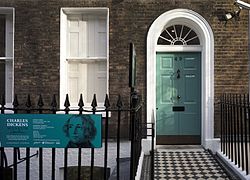Charles Dickens Museum
| Charles Dickens Museum | |
| Middlesex | |
|---|---|
 The Charles Dickens Museum | |
| Location | |
| Grid reference: | TQ30788220 |
| Location: | 51°31’25"N, 0°6’59"W |
| History | |
| Address: | 48 Doughty Street |
| Townhouse | |
| Information | |
The Charles Dickens Museum is the house where Charles Dickens and his family lived for over two years, at 48 Doughty Street in the King's Cross area, north of the City of London, in Middlesex. It is today an author's house museum.
The house is a typical Georgian terraced house, and it was Dickens's home from 25 March 1837 (a year after his marriage) to December 1839.
Dickens and Doughty Street
Charles Dickens and his wife Catherine Dickens (née Hogarth)]] lived here with the eldest three of their ten children. The elder two of their daughters, Mary, was born in the house.[1]
A new addition to the household was Dickens's younger brother Frederick. Also, Catherine's 17-year-old sister Mary moved with them from Furnival's Inn to offer support to her married sister and brother. It was not unusual for a woman's unwed sister to live with and help a newly married couple. Dickens became very attached to Mary, and she died in his arms after a brief illness in 1837. She inspired characters in many of his books, and her death is fictionalized as the death of Little Nell in The Old Curiosity Shop. Dickens had a three-year lease (at £80 a year) on the property. He would remain here until 1839 after which he moved on to grander homes as his wealth increased and his family grew. However, this is his only surviving London house.
The two years that Dickens lived in the house were extremely productive, for here he completed The Pickwick Papers (1836), wrote the whole of Oliver Twist (1838) and Nicholas Nickleby (1838–39) and worked on Barnaby Rudge (1840–41).
The Museum
The building at 48 Doughty Street was threatened with demolition in 1923, but was saved by the Dickens Fellowship, founded in 1902, who raised the mortgage and bought the property's freehold. The house was renovated and the Dickens House Museum was opened in 1925, under the direction of an independent trust, now a registered charity.[2]
Perhaps the best-known exhibit is the portrait of Dickens known as Dickens's Dream by R. W. Buss, an original illustrator of The Pickwick Papers. This unfinished portrait shows Dickens in his study at Gads Hill Place surrounded by many of the characters he had created.[3] The painting was begun in 1870 after Dickens's death. Other notable artefacts in the museum include numerous first editions, original manuscripts, original letters by Dickens, and many personal items owned by Dickens and his family. The only known item of clothing worn by Dickens still in existence is also displayed at the museum: this is his Court Suit and sword, worn when Dickens was presented to the Prince of Wales in 1870.
Pictures
-
Dickens's Dream, by Robert William Buss
-
Study
-
Basement kitchen
-
Mary Hogarth room
-
Dining room
-
Dickens's living room
-
Dickens's chair
-
The "Little Midshipman", referred to in Dombey and Son
-
Headstone of illustrator Robert Seymour
See also
Outside links
| ("Wikimedia Commons" has material about Charles Dickens Museum) |
- The Dickens Museum
- Charles Dickens Museum on The National Virtual Museum
- Charles Dickens Museum on Museums London directory of museums
References
- ↑ Lucinda Hawksley
- ↑ The Dickens House and the Dickens House Fund - Registered Charity no. 212172 at the Charity Commission
- ↑ "Charles Dickens Museum - Culture24". http://www.culture24.org.uk/se000016.









